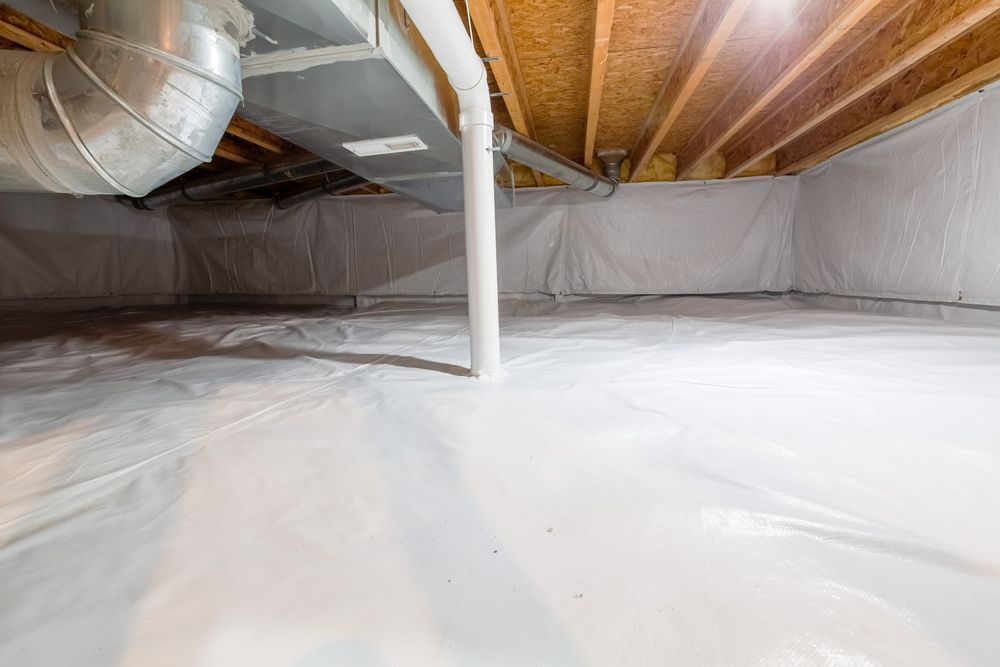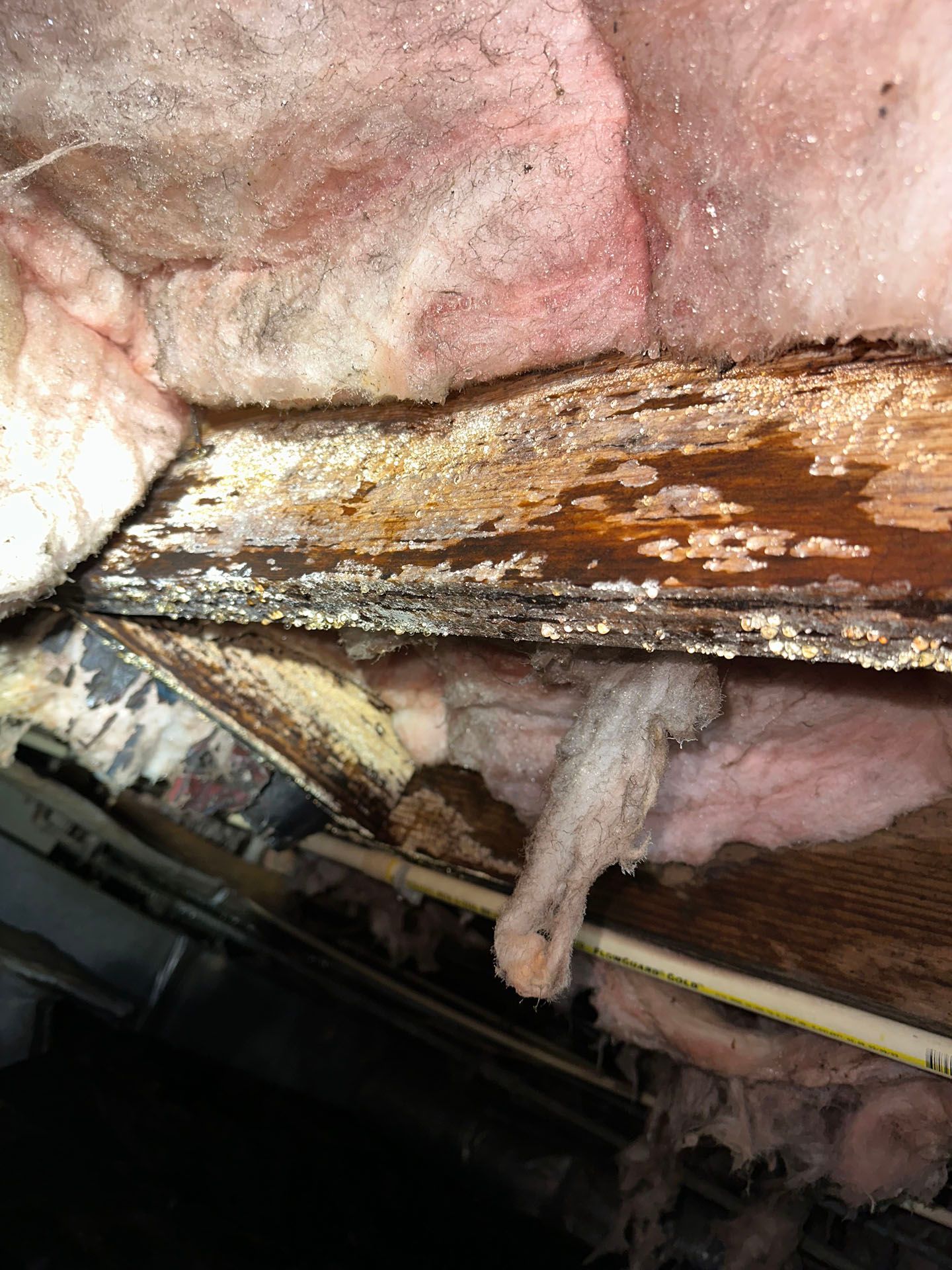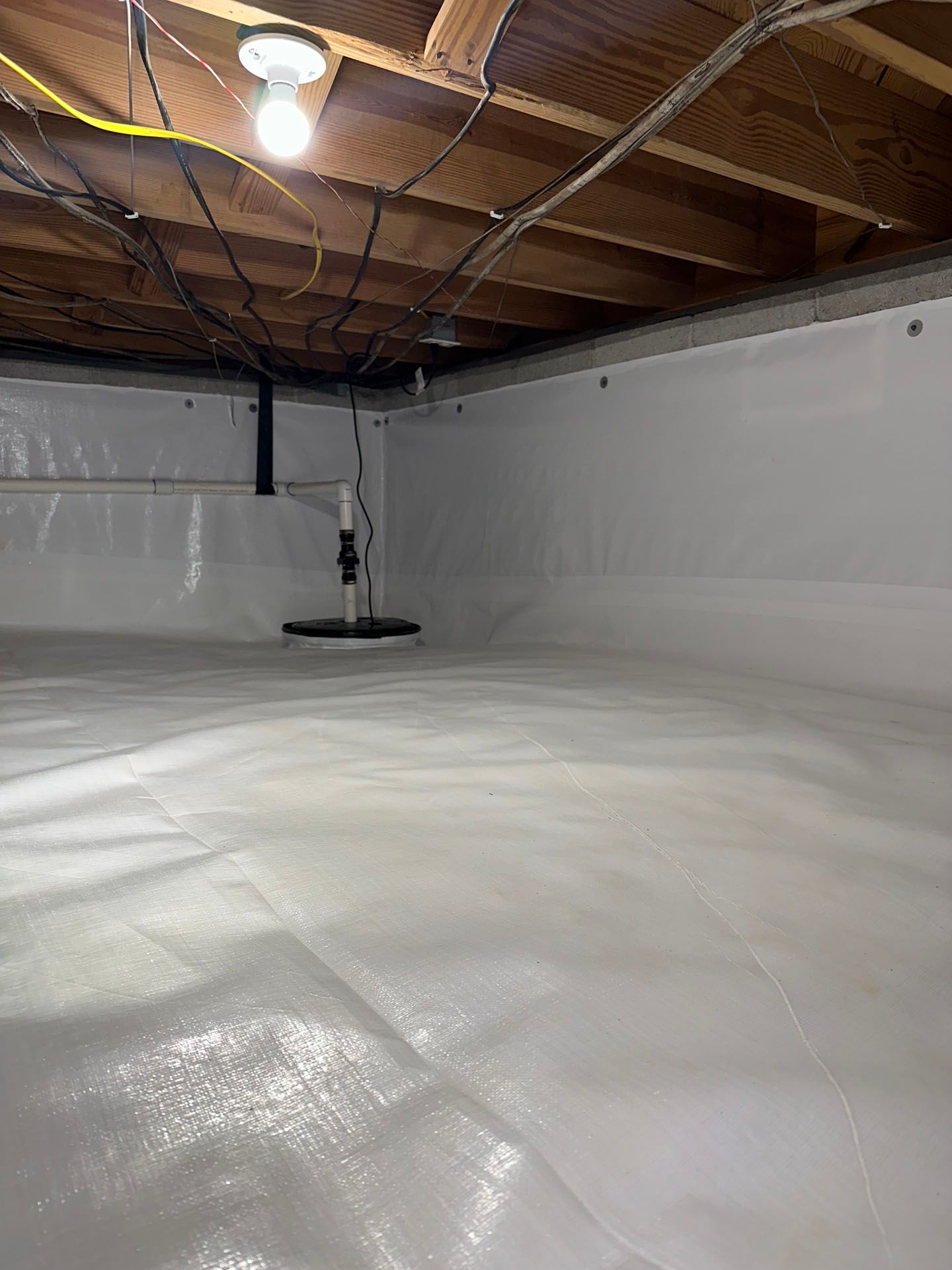Huntsville, Alabama

Claim Your FREE Crawl Space Inspection Today!
Sawyer Williams: 256-727-4422
Schedule Your Free estimate!
No-Obligation, Free Inspections
No-Obligation Free Estimates
We Warranty All of Our Work
100% Satisfaction Guaranteed
When it comes to home maintenance, the crawl space often gets neglected until a major problem arises. Even homeowners who are diligent about conducting regular maintenance may forget the importance of periodically assessing the condition of their crawl space.
Unfortunately, putting off such a task can be costly, leading to mold, rot, and decreased energy efficiency. Therefore, if you are wondering what potential issues may be lurking beneath your floorboards, never fear — this blog post is here to help! We're going to explore common crawl space problems and offer advice on how to solve them.
Quick Insight
The most common problems found in crawl spaces are pest infestations, mold and mildew, water damage, and insufficient ventilation. Poor maintenance can worsen these issues, so regular inspection and repairs are important.
Issues with Moisture and Mold
Moisture and mold in crawl spaces are among the most common issues homeowners face. While it’s normal to have some level of humidity in attics and crawl spaces, too much moisture can produce damp conditions that invite the growth of mildew and mold. These unhealthy fungi can cause allergic reactions and other respiratory problems, so managing these issues should be a priority.
Even if moisture controls are implemented, there is still potential for water to enter the space and cause problems such as condensation or pooling of water on top of insulation or floor joists. Homeowners should take preventive measures against moisture buildup, such as use fans to blow humid air out of the crawl space or having proper ventilation with air intake from outside the general area. Additionally, using a dehumidifier can help draw out excess moisture from a crawl space during humid summer months.
However, some homeowners might argue that increasing ventilation in a crawl space can bring unwanted microorganisms into their home, thus defeating the purpose of a true clean environment. Additionally, ineffective installation of insulation on foundation walls can lead to overly moist conditions, and fixing this issue requires more extensive renovations to ensure the home is properly insulated from outside elements.
Trapped moisture in crawl spaces can breed numerous other issues such as wood rot and unpleasant odors. In the next section we'll discuss how trapped moisture impacts wood structures and insulation in crawl spaces, along with identifying ways to control this problem before it worsens.
Trapped Moisture in Crawl Spaces
Trapped moisture in crawl spaces is a major issue for homeowners to consider. If you find that the space has higher than normal humidity, this could be indicative of trapped moisture. Too much moisture can create an inviting atmosphere for mold, mildew and other microscopic pollutants, leading to structural issues and poor indoor air quality.
Those with homes near water sources are especially at risk. The presence of standing water due to flooding, leaking plumbing or high ground water levels can quickly lead to excess moisture in the crawl space and should be addressed immediately. If caught early, these problems can be solved relatively easily.
Some experts recommend sealing off a damp crawl space from each other by using vapor retarders or other moisture barriers. This can help regulate the airflow within the space and reduce humidity levels within it. Sealing off the exposed dirt floor may also be necessary to prevent too much water from infiltrating below the surface. Additionally, utilizing a dehumidifier system may help control excessive moisture when necessary and elevate ambient temperatures by several degrees.
The great debate comes into play when discussing the best way to address trapped moisture in a crawl space. Some believe that installing a waterproof sealant will suffice while others claim that this solution is not lasting enough on its own and additional measures must be taken up front. Both sides have valid points which must be weighed carefully before making a determination as to what plan fits your particular situation best.
As we have seen, trapped moisture in crawl spaces is one of the most serious issues homeowners face and poses considerable risks if not addressed properly. In our next section, we will discuss ventilation of crawl spaces and how it can aid in preventing this problem altogether so that homeowners never have to worry about it again.
- According to a study conducted by NC State University, the most common problems found in crawl spaces include moisture/water damage (61%), ventilation issues (60%), and damaged floor joists (56%).
- A separate study conducted by researchers at the University of Florida found that 84% of homes with crawl spaces have inadequate subfloor ventilation.
- The same study reported that humidity levels in poorly ventilated and uninsulated crawl spaces regularly exceed 75%, which can create an environment conducive to mold growth and other structural damage.
Ventilation of Crawl Spaces
Ventilation of Crawl Spaces is an important topic to consider, as it can have an adverse effect on your home. Some argue that good ventilation helps decrease the likelihood of moisture content and accumulation in crawl spaces, enabling a healthier environment. On the other hand, some argue that with poorly sealed or insulated vents, heat loss will occur which increases humidity and moisture in the crawl space.
In order to make an informed decision about ventilation for your crawl space, you must understand the consequences of both viewpoints. Adequate insulation of the foundation walls, floors and ceiling should be taken into consideration when discussing proper ventilation for a crawl space. If insulation is neglected, then cold air from outside will enter and condense on foundation walls due to the warmer climate inside of your home. Ultimately this could lead to mold growth and consequent destruction of structural components within the home. Additionally condensation will occur due to moisture being released from your home's HVAC system that is commonly found in a crawl space. If not properly vented and charged, excessive moisture can build up in any areas directly below or near the HVAC system resulting in mold, wood rot and damage to other surfaces nearby.
It is imperative to ensure adequate insulation of foundation walls and floors for any situation where you intend to keep ventilation in your crawl space open since inadequate insulation will increase energy consumption and lead to higher energy costs in most cases. Additionally, proper sealing around air infiltration points such as doorways, windows and exhausts should also be carried out in order to reduce energy waste and possible attraction of insects into your home via crawlspace vents. To sum up, having adequate insulation as well as properly sealed vents are key components when deciding how to properly ventilate your crawl space accordingly.
Now that we know more about ventilation of crawl spaces let’s move on to another common problem - pest problems in crawl spaces.
Pest Problems in Crawl Spaces
Pest problems, such as rodents and insects, can be troublesome in crawl spaces. Many critters can access these areas and quickly overrun them, leading to a variety of health and structural risks. Rodents and certain species of bug carry diseases, attract more pests, and even damage building materials like wires or insulation. Unfortunately, removing these pests from crawl spaces is not as simple as baiting traps, spraying repellents, and calling it a day; preventative measures must also be taken.
The debate rages on as to whether potential pest problems in crawl spaces should be addressed immediately or if preventive measures should be implemented first. On one hand, it may be best to go ahead and contact an exterminator to target problem pests right away. Doing so will immediately stop the infestation from worsening and avert any property damages that could occur. On the other hand, it is certainly wise to take preventive steps like creating a physical barrier between the outside world and the crawl space to prevent new pests from entering in the first place and making sure no moisture builds up which can attract new pests from elsewhere.
Ultimately, when it comes to pest problems in crawl spaces, taking both immediate corrective action and proactive prevention measures is essential for truly solving the problem for good. By striking this balance of eliminating existing infestations while proactively keeping new ones out, homeowners can find peace of mind knowing their crawl space is safe. With that said, let’s now turn our attention to exploring how to effectively prevent pests from entering your crawl space in the first place.
Preventing Pests from Entering Crawl Spaces
Pests can cause serious damage to a crawl space and compromise its insulation, foundations and walls. Preventing pests from entering the area is much easier than getting rid of them once they've established nests or burrows. The best way to prevent pests from entering the space in the first place is to make sure all possible entry points are covered or sealed off. This includes any gaps or cracks in walls, under doors and around windows; these may be the entry points for insects, rodents and other creatures.
Outdoor pest control is also important – keeping shrubbery, weeds and other vegetation away from the house may help reduce the chances of them coming inside as well. Get rid of any standing water near your home since it can serve as a perfect breeding ground for many pests. Finally, use effective baits and traps to capture any potential intruders that have already entered the crawl space and are nesting there.
These practices can be beneficial in keeping pests at bay, however it is not always practical or feasible to prevent their entry entirely. Some pests such as termites can be difficult to eliminate without professional help and major structural changes or treatments to the building itself may become necessary over time. Additionally, some areas may suffer extreme levels of infestation due to climate change or environmental issues so careful inspection of these regions might be necessary often to detect any signs of pest activity.
Ultimately, prevention is always better than cure when it comes to preventing pests from entering crawl spaces, but sometimes additional measures will have to be taken in order to effectively address any existing problem. With this in mind, let's move on our next section about damage caused by pests in crawl spaces; walls, foundations, and insulation can all become victim to their destructive nature.
Damage to Crawl Space Walls, Foundations, and Insulation
Damage to the crawl space walls, foundations, and insulation can lead to serious problems down the road. Poorly maintained crawl spaces can become entry points for water, mold, and pests, while also leading to increased energy bills. Even minor damages, such as cracks in the walls or insulation, can cause future issues that should be addressed as soon as possible.
One method of addressing damage to a crawl space is by sealing cracks with spray foam insulation. This is best done by a professional who can accurately diagnose any problem areas and apply the appropriate sealant. It's important to note that this type of repair does not address foundational issues though, so it's important to have a structural engineer inspect the space for any underlying instabilities that may exist.
Foundation repair is a more involved process which involves excavation and re-inforcement work depending on the severity of the problem area. Repairing damaged foundations could include replacing sections of rotten framing with new pressure treated lumber, or repairing broken concrete foundations with epoxy injections or helical piers. Many contractors advertise “foundation repair” services, but it’s important to always do your research and hire a qualified professional with experience in foundation repairs.
Insulating crawl spaces is also an important step in avoiding further damages down the road caused by water and pests. Insulation options vary depending on needs and budget but two main types are typically used; blanket rolls or batts of fiberglass insulation or spray foam insulation applied directly on existing surfaces. Many homeowners overlook this step—which should not be taken lightly since a well-insulated crawl space reduces heating/cooling costs.
All these aspects need to be considered when assessing damage in a crawl space and determining what steps will need to be taken in order for it to function correctly again. After all repairs have been completed, homeowners should always conduct regular inspections for any potential future damages in order to maintain their crawl spaces in good condition. Now let's look into another very common issue: Leaking and Flooding in Crawl Spaces which we'll explore next.
Leaking and Flooding in Crawl Spaces
Leaking and flooding in crawl spaces is a major issue for homeowners and can lead to serious damage to the property, if not detected in time. Depending on the cause of the leak or flood, repairs can vary from simple solutions such as replacing sealant, to more complicated solutions like installing waterproofing systems.
For mild to moderate cases of leaking or flooding, the first step should always be finding and fixing the source of the problem. In most cases this can often be traced back to a breach in the exterior walls, or deficiencies in drainage or air circulation systems. It is also important to check plumbing fixtures for leaks, or other common sources of water such as faulty hoses or condensation lines.
Once the source has been found and fixed, any excess water must be pumped out and all affected areas dried out thoroughly. It's also vital to ensure that no further water will be entering the area during these repairs; otherwise, they can become futile in preventing future problems.
In some cases however, it is best to pursue a more comprehensive solution such as installing interior waterproofing systems, something best left to an experienced professional. Using an interior system will help contain water within a designated area instead of allowing it to spread throughout the crawl space. This type of system could be especially useful in cases with heavy rains or other extreme weather conditions where constant vigilance is necessary.
Finally, it’s important to understand that prevention is key when it comes to keeping your crawl space dry. Regularly inspect all entry points such as drainage lines and other vulnerable places around your home where water could enter. Promptly repair any visible crack on exterior walls and monitor humidity levels inside your crawl space using a device known as a hygrometer so that you remain aware of any sudden changes in moisture levels before any significant damage occurs.
By taking these steps you can help protect yourself from dealing with expensive damages resulting from leaking and flooding in your crawl space. Now let’s move onto addressing another potential hazard: debris and other critters in crawl spaces.
Must-Know Points to Remember
Leaking and flooding in crawl spaces can cause property damage but many of the solutions are easy to implement if caught in time. Steps of action include fixing the source of the problem, pumping out any excess water, and drying out affected areas. Installing an interior waterproofing system is more comprehensive solution best left to a professional for heavy rain or extreme weather conditions. Prevention is key so regularly inspect entry points and repair cracks with exterior walls, as well as monitor humidity levels using a hygrometer. Debris and critters can be a potential hazard so taking action to address those hazards is also recommended.
Debris and Other Critters in Crawl Spaces
Apart from the health and safety risks posed by dampness and poor insulation, another large concern is when debris and other critters enter a crawl space. Whether it’s old newspapers, leaves, or small animals, the presence of debris or critters can quickly become problematic in a crawl space.
On one hand, some argue that this isn’t an issue thanks to pest control and extermination methods available on the market today. Others posit that insects and rodents aren’t necessarily the only thing to consider – larger animals such as snakes also pose a threat. Even birds are prone to nesting in crawl spaces due to their easy access.
In addition to wildlife, debris often accumulates quite quickly without regular maintenance. Even something as small as a misplaced cardboard box can cause an influx of spiders and dust mites if left alone too long. Keeping your crawl space clean is important for avoiding not only pests but also decay, mold, and other associated hazards.
Now that we’ve discussed the various issues concerning debris and critters in crawl spaces, let's move on to solutions for these common problems.
Solutions for Common Crawl Space Problems
Crawl spaces are an integral part of many homes, but unfortunately can easily become a source of water-related issues, musty odors, and various other problems. Fortunately, these issues tend to have straightforward solutions that can be taken on by homeowners themselves or with the help of a professional.
One of the most common issues with crawl spaces is condensation from high humidity levels. Installing a dehumidifier in the area can help significantly reduce moisture levels and prevent future complications. It’s important to make sure that the unit has the correct capacity for your specific space, as the size and ventilation have an effect on how effectively it works. If you’re looking for a more permanent solution, polyethylene vapor barriers and air circulation systems can also be used to help protect against moisture buildup.
Insect infestations often manifest themselves in unlined crawl spaces. To address this issue quickly, look into hiring an exterminator who specializes in bug removal. Depending on the type of pest you’re dealing with, they may recommend certain types of sprays or traps to get rid of it from your home. For more long-term solutions, an insulation package and foundation vents may help keep out pests over time.
Mold is another problem that commonly affects crawl spaces due to excess moisture in the air. Using industrial-grade detergents with bleach or vinegar will help remove any surface-level mold growth and discourage growth in the future. If the space is overly damp or your mold situation is extensive, you may need to consult with a specialist to develop a deeper plan of attack — one which could include replacing insulation materials and carrying out repairs along with applying disinfectant and antifungal solutions.
Lastly, nasty smells originating from crawl spaces can be fixed by pinpointing their sources and addressing them accordingly. If mold or mildew is present, dealing with those first should help mitigate odor production. You may also want to consider installing a filtration device like an activated charcoal filter fan that helps control aeration levels within the space — improving air quality and eliminating bad smells in turn.
Now that we’ve discussed some viable solutions for common crawl space issues, let's take a look at some final considerations for ensuring optimal maintenance going forward in our next section.
Final Considerations for Crawl Spaces
Before making final decisions regarding crawl space repairs and maintenance, it’s important to take some additional factors into account. The following considerations should be investigated prior to any major repair decisions.
1. Water control: Unless steps are taken to control the amount of water that gets into the crawl space, any previous repairs could be rendered useless. While there are a variety of solutions available, from drainage systems to sump pumps and encapsulation, the most effective solution depends on a range of factors including the magnitude of the water issue in your particular crawl space as well as any local building codes that may apply.
2. Sealing: Prior to making any other repairs or doing any encapsulation, seal any air gaps around plumbing lines, wires, and vents using caulk and/or insulation foam. This can help prevent future moisture issues while improving ventilation and potentially reducing utility costs.
3. Insulation: Poor insulation is one of the main contributors to high energy bills and uncomfortable living spaces in most homes. Since temperature differences between air in the crawl space and air in the rest of your home will make your HVAC system work harder than necessary, make sure to inspect insulation in the area and consider replacing it if necessary.
4. Vents: In most cases, venting out crawl spaces is essential for maintaining an adequate level of humidity within the structure. Whether open or screened vents should be used depends mainly on local climate conditions; however, some experts also suggest installing insulated baffles over existing vents when appropriate since this could improve air flow and minimize condensation near cool surfaces during winter months.
5. Long-term maintenance plan: Once all repairs have been made, it’s important to put together a long-term maintenance plan for your crawl space which includes periodic inspections as well as appropriate proactive steps such as checking hoses and drains for signs of wear or blockages every few months and else cleaning away any debris or mold periodically whenever they’re noticed. Regular maintenance will go a long way toward keeping your crawl spaces healthy and humidity levels under control over time.
The debate as to whether or not vented crawl spaces are beneficial is ongoing among industry professionals; some argue that vented crawl spaces promote proper air exchange while others point out that relying solely on these allows moisture-laden air inside the house where it can lead to mold growth and structural damage; talking with a qualified inspector might be a good idea if you’re undecided about what solution is best for your situation.
Common Questions and Explanations
What can cause damage to a crawl space?
Damage to a crawl space can be caused by a range of factors, including:
1. Poor drainage - Poor drainage in the surrounding area of the crawl space can lead to water collecting around the foundation and seeping in. In extreme cases, this pooling of water can cause significant damage.
2. Humidity - High levels of humidity in a crawl space can lead to the growth of mold or mildew, which can damage structural components like joists, studs, and other structural support elements.
3. Pests - Pests like mice and insects can cause damage to structural components by chewing through walls and floorboards or by creating nests within your crawl space.
4. Structural issues - Structural issues such as uneven settling of foundations or improper installation of beams or joists can cause severe damage to both the foundation itself as well as any pipes, wiring, or ductwork that may run through the crawl space.
What are the signs of a problem in a crawl space?
The signs of a problem in a crawl space can vary, but some of the most common indicators include:
1. Unpleasant odors - musty or moldy smells could indicate moisture issues or poor ventilation.
2. Excessive moisture - condensation on walls or pipes and wet soil and wood may mean that there is inadequate drainage, leaks, flooding, or other water-related problems in the crawl space.
3. Pest infestations - signs of rodents, insects, spiders, and other pests can suggest there are current problems in your crawl space.
4. Structural damage – warped floors, buckling walls, and uneven support beams could be an indication that there are structural problems in your crawl space due to poor insulation, improperly sealed vents, or poor ventilation.
5. Mold growth – if you notice visible growth or discolored spots on walls and floors it may mean that there’s a mold problem that is affecting the air quality inside your home or business.
6. Mildew - yellowish or grayish stains located on wood/floor beams as well as mushroomy odor signifies mildew activity that can cause health related issues for you and your family members.
7. Insulation damage – collapsed insulation, torn protections, and loose pieces speaks to insulation problems which leads to higher energy costs and environmental damage due to loss of flexibility in material performance.
What steps can be taken to avoid common crawl space problems?
1. Make sure the crawl space is properly insulated and well-ventilated at all times. Adequate insulation can help keep the temperature inside the crawl space stable and reduce moisture accumulation. Proper ventilation will ensure that outside air circulates through the space, preventing mold and mildew growth.
2. Check for pest infestations regularly, as this is one of the most common causes of problems in crawl spaces. Be sure to also check for signs of animal droppings or any other damage caused by animals. If pests are found, have an experienced technician remove them as soon as possible.
3. Regularly perform maintenance on any pipes or wiring that runs through the crawl space. Checking for leaks or other damage and making small fixes right away can prevent larger problems down the road. It’s also important to make sure the waterproofing membrane below the flooring is intact to avoid flooding in case of heavy rains or leaks.
4. Install a sump pump in areas prone to flooding, such as basements and crawl spaces, to quickly remove any water that accumulates there due to storms or other incidents. It's also a good idea to have a backup generator connected to your sump pump in case of an emergency power outage.
5. Place ground cover material over dirt floors in a crawl space to reduce radon gas concentrations around your home and prevent moisture from entering your home through the foundation walls.
Following these steps can help you avoid common crawl space problems and keep your home safe from mold, mildew and pest infestations.

Written by Sawyer Williams
Precision Crawlspace & Renovations
Sawyer has specialized in crawl space and foundation repairs for over six years. As the founder of Precision Crawlspace and Renovations, he is one of Huntsville's top experts in crawlspace moisture control. He has prior experience installing these systems, which has prepared him to solve complex problems related to crawl space encapsulation, mold remediation, and waterproofing.
Recent Blog Posts
Huntsville's Crawl Space News



What are you waiting for?
We Solve Crawl Space Issues!
Get reliable crawl space repair services at an affordable price, provided with the high level of service you deserve.
Call Us Today at: 256-727-4422
All Rights Reserved | Precision Crawlspace & Renovations

